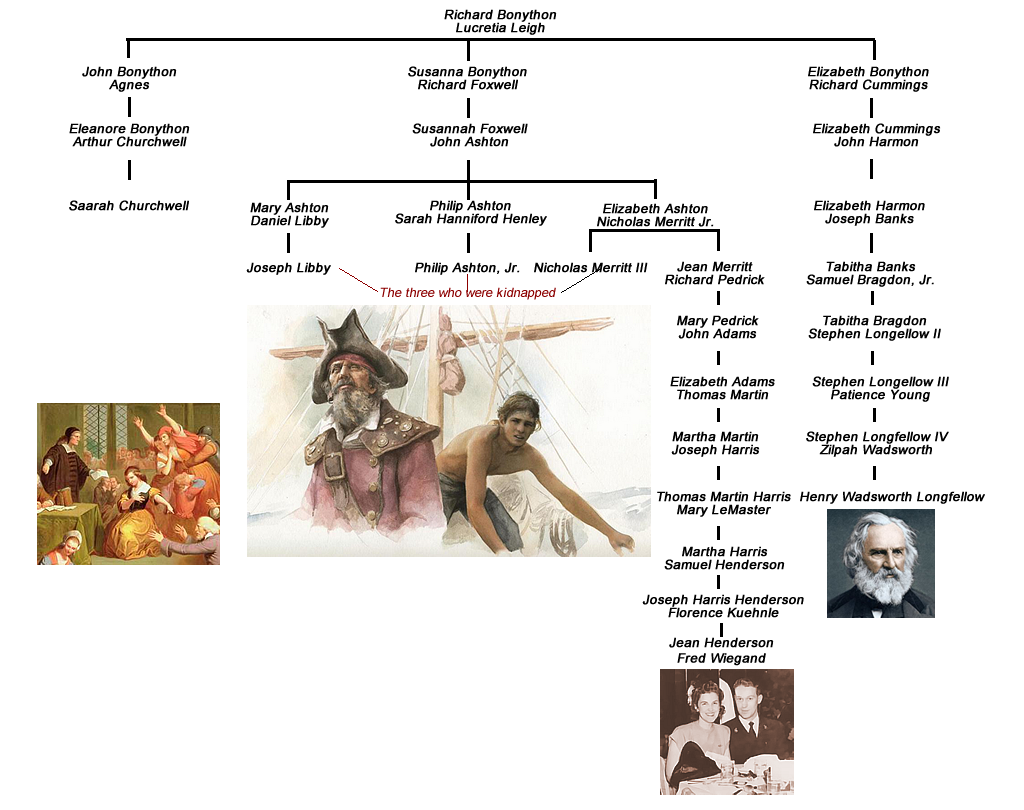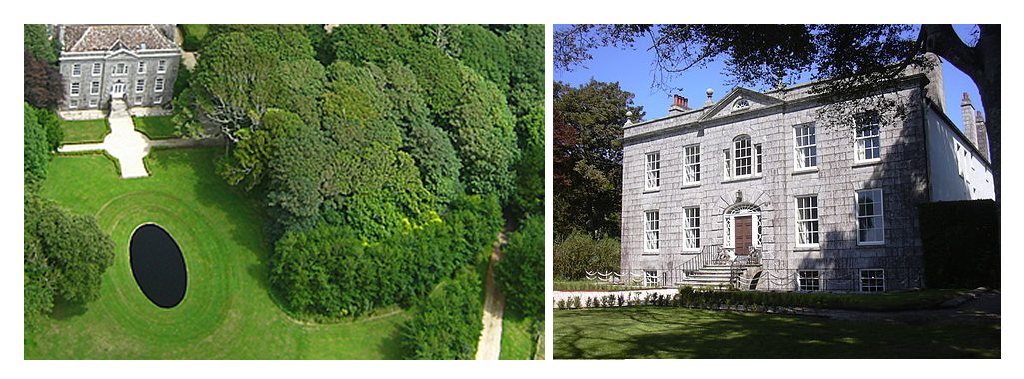Richard Bonython - Lucretia Leigh Family Group
| Parents | Parents | |||||
| John Bonython | Eleanor Myleintin | William Leigh | Philippa Prest | |||
| b. St. Breage Cornwall, England | b. St. Breage, Cornwall, England | b. St. Thomas by Launceton, Cornwall, England | b. St. Thomas by Launceton, Cornwall, England | |||
| d. | d. | d. St. Thomas by Launceton, Cornwall, England | d. St. Thomas by Launceton, Cornwall, England | |||
| HUSBAND | WIFE | |||||
| Captain Richard Bonython |
Lucretia Leigh |
|||||
| bp. 8 Apr 1580 St. Columb Major, Cornwall, England | b. St. Thomas by Launceston, Cornwall, England | |||||
| d. Before 1654 in York County, Maine, USA | d. After 1647 in York County, Maine, USA | |||||
| Relationship Events | ||||||
| Marriage | By about 1607 | Richard Bonython to Lucretia Leigh in England | ||||
| Children | ||||||
| John Bonython abt. 1607 in Cornwall, England; m. Agnes (possibly Gavrigan) in England by about 1650;five children: Thomas, John, Eleanore, Gavrigan, and Winifred Bonython | ||||||
| Francis Bonython buried St. Breage Cornwall, 22 Jan 1609/10 (an infant). | ||||||
| Grace Bonython bp. St. Breage, Cornwall, 19 Apr 1610; no further record | ||||||
| Elizabeth Bonython bp. St. Breage, Cornwall 20 Sep 1612; m. Richard Cummings (d. abt. 1675in York County, Maine ab out 1647; two children: Elizabeth and Thomas Cummings
|
||||||
| Susannah Bonython bp. St. Breage, Cornwall, 5 Feb 1614/15; m. Richard Foxwell in York County, Maine by 1635; eight children: Richard, Esther, John, Lucretia, Susannah, Philip, Mary, and Sarah Foxwell | ||||||
What We Know About This Family
Noteworthy
Captain Richard Bonython moved his family from Cornwall when he received a patent at Saco, Maine. Son John was the grandfather of Sarah Churchwell, first a confessor, then an accuser in the trial of her employer, George Jacobs, Sr., that led to his hanging in Salem in 1692.
Daughter Elizabeth was the fifth great-grandmother of American poet, William Wadsworth Longfellow.
Daughter Susannah was the grandmother of three young Marblehead mariners captured by pirate Ed Lowe. Phillip Ashton, Jr. escaped on an uninhabited island where he lived for a year until rescued by a Salem schooner and was known as Marblehead's Robinson Crusoe. His cousin, Joseph Libby, joined the pirates and was captured and hanged with 26 others in Rhode Island.

An Overview of Their Lives
First, not Bonnie-Thon as I pronounced it when I first saw it, but Be-Night-on to rhyme with "python." Three of Richard's grandchildren were married as "Benighton" in Lynn and Marblehead. Richard Bonython was a second son in a family that belonged to the English gentry in Cornwall. His father John had inherited the Bonython manor in the parish of Cury near Land's End, but Richard was born at his mother's family's estate in St. Columb Major on the north coast of Cornwall. The Bonython estate in modern times has been taken over by new owners, who have renovated the original Georgia manor and landscaped the property with beautiful gardens available to the public. The property lies close to the filming of Poldark, and Gweek, Bottalack, and Levant are reminiscent of places featured in the novel Penmarric by Susan Howatch.

As a second son and not in line for the manor's inheritance, Richard trained in the military and commanded a company in the wars against France, earning himself the rank and title "Captain."
On 29 Feb 1629/30, the Council for New England granted to Richard Bonython and his partner Thomas Lewis the proprietorship of Saco in what is now Maine. Lewis had visited earlier, and returned to the new land to take charge of the patent while Bonython stayed to recruit the 50 people to be sent over within seven years. It's not known exactly when he himself arrived in Saco, but his house was ready by 25 Mar 1636 when the first Court in the Province was called by William Gorges and held at the Bonython house. One of the items heard that day concerned the child conceived by John with his father's servant, Ane. Some historians believe this Ane may have been the Agnes whom he married.
On 14 Jul 1647, Captain Bonython exchanged 100 acres of land with Dr. Robert Child for his daughter Elizabeth and son-in-law, Richard Cummings. The documents were witnessed by Elizabeth Bonython and Lucretia Bonython, so we know that Lucretia accompanied her husband and their three surviving children to the New World and that she was still living in 1647.
Captain Richard and his wife Lucretia were spared the ravages of the Indian hostilities and King Philip's War that resulted in the depopulation of European settlers in Maine until the wars ended. Their son John may have died of injuries sustained in an attack by Indians. The parents of the husband of John's daughter, Winifred, were killed an in attack that also killed two men at her Aunt Susannah Foxwell's property. Their grandson John, his wife, and four of their seven children were carried off by Indians and never seen again. Richard's great-grandson, Nathaniel Foxwell, Susannah's grandson, was also killed in a battle with Indians in 1703. The families fled from Saco to the Marblehead area, and the Bonython name in America died out although the bloodline continued through the many descendants (including us) of the Bonython women and their husbands. The Documents section contains articles about the Bonythons from which the information here was drawn.
About the Children
- John Bonython gained a reputation in his character that is referenced in numerous records. He had a violent temper and was known for insubordination. He was twice outlawed, a price put on his head, and imprisoned in Boston. The aggravations he caused to the community did not exempt his own family. On 29 Jun 1654, Richard's two sons-in-law, Richard Cummings and Richard Foxwell, were plaintiffs in an action of trespass against Mr. John "Bonighton,"who apparently pulled down their house and laid claim to their land. We know by this action that John's father, Captain Richard Bonython had died before this date. In spite of his temperament, he held some important positions. He married Agnes whose last name was perhaps Gavrigan (a surname found in their homeland in Cornwall and given to one of their sons), and they had five known children. He lived on his father's patent from 1653 until King Philip's War. About September 1675, the house was burned down by Indians, and he fled with his family to Marblehead. His will was written there 17 Feb 1676, and he died later of his wounds. His daughter, Eleanor, carried on his family tradition with court appearances of her own. She married Arthur Churchwell and their daughter Sarah was involved in the Salem witchcraft trials when she testified against her employer, who was found guilty and hanged. An article about Sarah Churchwell states she may have suffered what we call today call post-traumatic stress when she and her family suffered an Indian attack at her grandfather's home. She also paid a fine for fornication before she married later in her life. John's son, Thomas, was ill while his father was making out his will and died without issue. John, Jr. was in Kittery from 1694 to 1703 when he, his wife, and five of their children were carried off by Indians and never seen again. His three remaining children, two daughters and a son, married in the Marblehead/Lynn area using the name Benighton. Gavrigan drowned and left no heirs. Winifred married Robert Nichols or Nicholson. A Major Waldron wrote of events in King Philip's War that “Indians had killed an old man and woman and burnt their house, and at Foxwell’s, two young men were killed.” The old man and woman killed as stated above were the Nichols, the parents of Robert Nichols, Jr.
- Elizabeth Lucretia Bonython married Richard Cummings before 1652. Cummings was a fisherman/mariner who in partnership with Thomas Turbin bought a plantation on the Pascataqua River in 1645. In addition to the land granted to him by his father-in-law, He had a lot in Portsmouth assigned to him in 1647 They had two children. Cummings' probate was administered by his son, Thomas, and his daughter's husband, John Harmon in 1675. Thomas died not long after his father, and Elizabeth had one daughter before she died and her husband married the widow of one of the Foxwell sons.
- Susannah married Richard Foxwell who settled at Blue Point on the Scarboro River in 1636 when he was 32. Described in the source about the settlement of Saco, Foxwell was described as one of the oldest and most respectable planters on the area. Foxwell, being an early arrival to America and as such has an entry in Great Migrations, which gathers information about court appearances as well as other facts. They had eight children. Their daughter, Susannah is our direct ancestor and was the second of the three wives of John Ashton. The Foxwells are our direct ancestors and have their own family group page.
Our Marblehead branch was affected in the early generations by the Indian Wars, which created an exodus of the surviving European settlers in Maine to areas of Massachusetts including Marblehead. The Parkers at Georgetown suffered casualties and had their home burned down. Shelter at Marblehead led to some permanent settlings there. It is commonly believed that our direct ancestor, Mark Pitman, who lived in Marblehead, was an early casualty of the war. (His son Moses married Remember Parker). Much has been written about the Bonyhon family and their early descendants. Some of the interesting articles are included in the Documents section.

Proof of Relationship
Analysis of the wills and deeds in Maine established the relationships.
What Else We Need to Learn
The goal of this project is to trace every line of ancestry to the arrival of its first immigrant to America. The basic information of each couple is considered complete when we know the dates of birth, marriage, and death for both spouses. their parents' names (or whether they were the immigrant), and the child or children in our ancestry line.
The research on this family is complete.

